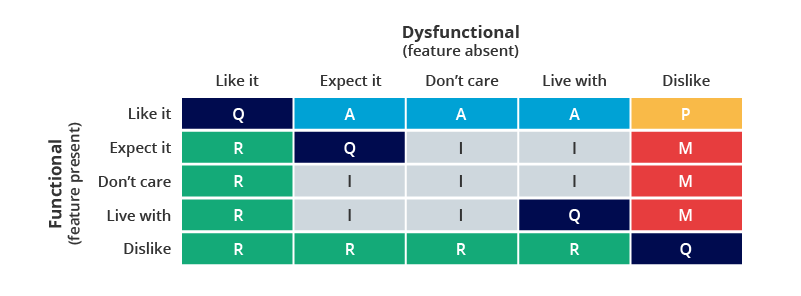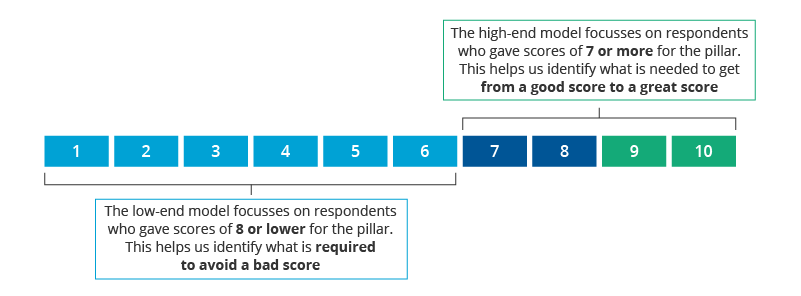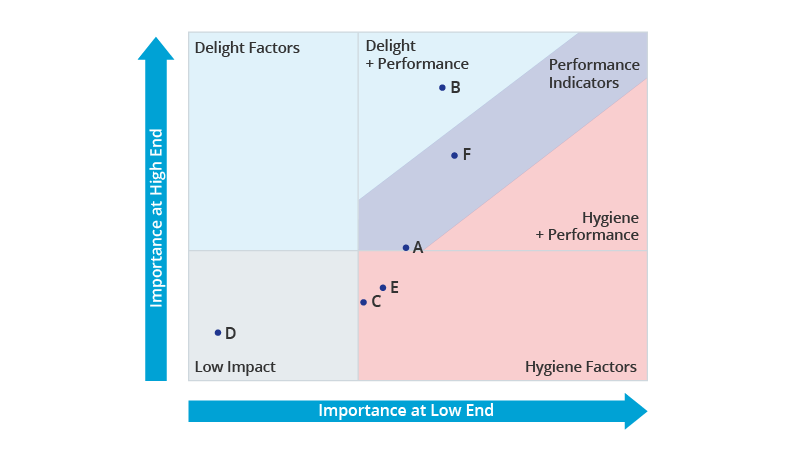
Introducing The Kano Classification Model
It is fairly common when dealing with product development projects to attempt to in some way quantify the importance of certain features or attributes that the product may possess to the appeal of the product as a whole. This is obviously a valuable insight to have but sometimes this overlooks a fundamental difference in the role played by different attributes when it comes to selecting a suitable product. The Kano model attempts to sort features and attributes by these roles to give more context to these insights.
If you think back to a recent purchase you’ve made you will often start with a shortlist of key features or attributes you are looking for which must be present for the product to be considered. These are essential to a product being acceptable, but are not something that will excite the buyer. Examples might include the presence of basic functions or features like a car having 4 wheels or a printer being compatible with your computer. Under the Kano model these sorts of attributes are generally referred to as “Hygiene Factors” or “Threshold Attributes”.
Other features may not be required for a product to be acceptable but make the product more desirable when they are present. These might include things like two-tone paint on a sportscar or a “macro mode” function for your smartphone camera. These are referred to as “Delight Factors” or “Excitement Attributes”.
The third category of interest consists of the key measures by which the performance of a product is judged. This might include things like horsepower for a sports car or maximum lift load for a crane. These are referred to as “Performance Indicators” or “Performance Attributes”.
Some attributes may not show strong importance at all and my be seen as irrelevant to the appeal of the product. These are referred to as “Indifference Attributes”.
It has been observed that these roles can evolve over time, with the delight factors of today sometimes becoming the hygiene factors of tomorrow. An example of this is how the inclusion of a digital camera in a mobile phone has gone from a novelty and a delight factor when it was first introduced, to being a basic expected feature today.
It is important to note that these roles are tied to the needs and wants of the purchaser and so we can expect some segmentation in how this breaks down. A parent buying a car for the school run will have a different set of Hygiene factors, Performance Indicators and Delight Factors than someone buying a car for leisure and prestige.
The Kano Exercise
The traditional way to categorize attributes and features according to the Kano model is to conduct a Kano exercise. This involves asking the following two questions about each feature or attribute being tested:
-
How would you feel if the product did have the following property?
- I like it
- I expect it
- I am neutral
- I can tolerate it
- I dislike it
-
How would you feel if the product did not have the following property?
- I like it
- I expect it
- I am neutral
- I can tolerate it
- I dislike it
The intent here is to measure the range of possible emotional responses that varying functionality with respect to one aspect of performance can achieve.
Ideally we want to measure the reaction to finding out a product totally fails to fulfil this function and comparing it to their reaction to a product that maximally fulfils this function. This can be a little tricky.
The standard language used for the questions is often not up to the task and may need to be tweaked to make more sense in the context.
For each respondent the attribute is classified based on the pair of responses given.
A – Where responses range from “OK” to “Great” indicate a delight factor
M – Where responses range from “Terrible” to “OK” indicate a hygiene factor
P – Where responses range from “Terrible” to “Great” indicate a performance measure
I – If they don’t really care either way then we can conclude that it’s unimportant
R – Occasionally we will get something that actually hurts the product! The more you deliver, the less satisfied they are. This could be something like bringing “Clippy” back to Microsoft Office…..
Q – Certain response patterns don’t really make sense and can be used as a quality control during the data cleaning process.
This provides us with a classification for all the attributes/features we tested for each respondent. We can use this to identify what role each feature/attribute generally plays as well as to identify any prominent needs segments within the market. These insights are particularly useful when we are attempting to develop a range of products to address the market and want to understand what the basic model should include and if multiple premium extensions would unlock more of the market for us.
It is worth noting that the Kano exercise does not measure the relative importance of these factors. It is focused solely on the nature of the role played by each feature/attribute in selecting a product. If we want to understand the importance each of these has then we need to follow it up with something that measures importance (such as a MaxDiff exercise).
Kano Regression Modelling
Another way to employ the Kano Classification Model is to measure the interaction of delivery on various attributes on overall satisfaction with the product implicitly through regression modelling.
To conduct this analysis we need to have collected a large amount of satisfaction data for all the attributes we want to test along with the overall satisfaction of the respondent with the product.
We can then create a pair of linear regression models each focusing on a different subset of respondents.
-
The low-end model focusses just on respondents giving an overall satisfaction score of 1 to 8.
-
The high-end model focusses instead on all respondents giving an overall satisfaction score of 7 or more.
We can then identify which attributes are important drivers of overall satisfaction at the low-end and high-end of the satisfaction scale and use this to categorize the attributes according to the Kano Classification.
| Important at Low End | Important at High End | |
|---|---|---|
| Hygiene Factor | ✅ | ❌ |
| Delight Factor | ❌ | ✅ |
| Performance Indicator | ✅ | ✅ |
| Low Impact | ❌ | ❌ |
Some attributes may be strong drivers in both models but be more dominant in one than the other. This suggests they play dual role as a Performance Indicator and either a Delight Factor or Hygiene Factor (depending on which model they are stronger in).
Using Shapley Regression or Relative Importance Analysis, we can even plot the importance of each attribute in each model to get a visual expression of this classification.
This approach is a great way to add context to insights about the relative importance that these attributes have but only measures the typical role of each attribute across the sample, rather than for each respondent. As such it is less useful in identifying needs based segments. By quantifying the contribution of each attribute at either end of the satisfaction scale though it does allow us to track the evolution of the roles of these attributes over time and predict when features are transitioning into being hygiene factors (and therefore identifying where existing solutions which lack these features may cease to be suitable for the market).
It can be an excellent addition to a CX study aiming to help focus resources towards customer retention and advocacy. Hygiene factors can be targeted to prevent customers from leaving, while delight factors can be harnessed for messaging in order to effectively drive advocacy.
It is also worth remembering that this method requires relatively large bases to produce reliable results as we need a suitably large base for both the low-end and high-end models.
Parting Thoughts
Kano Classification is a useful tool in enriching the insights we can draw from satisfaction research and supporting product development efforts. It is particularly valuable when attempting to develop or evolve a product range designed to efficiently meet the needs of a segmented market. If you are planning some product development research, a Kano exercise may be a good step to consider including in order to generate more contextualized insight and when conducting CX research, Kano Regression may help provide a clearer picture of what is causing loss of customers or driving advocacy.
Readers of this article also viewed:
How Design Thinking Can Help Drive B2B Innovation How to Use Product Development Research to Innovate Successfully Getting Concept Testing Right





